python+request+HTMLTestRunner+unittest接口自動化測試框架
轉自https://my.oschina.net/u/3041656/blog/820023
正在調研使用python進行自動化測試,在網上發現一篇比較好的博文,作者使用的是python3,但目前自己使用的是python2,先轉載下,後續再進行調試完善;
摘要: python + requests實現的接口自動化框架詳細教程
前段時間由於公司測試方向的轉型,由原來的web頁面功能測試轉變成接口測試,之前大多都是手工進行,利用postman和jmeter進行的接口測試,後來,組內有人講原先web自動化的測試框架移駕成接口的自動化框架,使用的是java語言,但對於一個學java,卻在學python的我來說,覺得python比起java更簡單些,所以,我決定自己寫python的接口自動化測試框架,由於本人也是剛學習python,這套自動化框架目前已經基本完成了,於是進行一些總結,便於以後回顧溫習,有許多不完善的地方,也
1、首先,我們先來理一下思路。
正常的接口測試流程是什麽?
腦海裏的反應是不是這樣的:
確定測試接口的工具 —> 配置需要的接口參數 —> 進行測試 —> 檢查測試結果(有的需要數據庫輔助) —> 生成測試報告(html報告)
那麽,我們就根據這樣的過程來一步步搭建我們的框架。在這個過程中,我們需要做到業務和數據的分離,這樣才能靈活,達到我們寫框架的目的。只要好好做,一定可以成功。這也是我當初對自己說的。
接下來,我們來進行結構的劃分。
我的結構是這樣的,大家可以參考下:
?????? common:存放一些共通的方法
result:執行過程中生成的文件夾,裏面存放每次測試的結果
testCase:用於存放具體的測試case
testFile:存放測試過程中用到的文件,包括上傳的文件,測試用例以及 數據庫的sql語句
caselist:txt文件,配置每次執行的case名稱
config:配置一些常量,例如數據庫的相關信息,接口的相關信息等
readConfig: 用於讀取config配置文件中的內容
runAll:用於執行case
既然整體結構有了劃分,接下來就該一步步的填充整個框架了,首先,我們先來看看config.ini和readConfig.py兩個文件,從他們入手,個人覺得比較容易走下去噠。
我們來看下文件的內容是什麽樣子的:
[DATABASE]
host = 50.23.190.57
username = xxxxxx
password = ******
port = 3306
database = databasename
[HTTP]
# 接口的url
baseurl = http://xx.xxxx.xx
port = 8080
timeout = 1.0
[EMAIL]
mail_host = smtp.163.com
mail_user = xxx@163.com
mail_pass = *********
mail_port = 25
sender = xxx@163.com
receiver = [email protected]/[email protected]
subject = python
content = "All interface test has been complited\nplease read the report file about the detile of result in the attachment."
testuser = Someone
on_off = 1相信大家都知道這樣的配置文件,沒錯,所有一成不變的東西,我們都可以放到這裏來。哈哈,怎麽樣,不錯吧。
現在,我們已經做好了固定的“倉庫”。來保存我們平時不動的東西,那麽,我們要怎麽把它拿出來為我所用呢?這時候,readConfig.py文件出世了,它成功的幫我們解決了這個問題,下面就讓我們來一睹它的廬山真面目吧。
import os
import codecs
import configparser
proDir = os.path.split(os.path.realpath(__file__))[0]
configPath = os.path.join(proDir, "config.ini")
class ReadConfig:
def __init__(self):
fd = open(configPath)
data = fd.read()
# remove BOM
if data[:3] == codecs.BOM_UTF8:
data = data[3:]
file = codecs.open(configPath, "w")
file.write(data)
file.close()
fd.close()
self.cf = configparser.ConfigParser()
self.cf.read(configPath)
def get_email(self, name):
value = self.cf.get("EMAIL", name)
return value
def get_http(self, name):
value = self.cf.get("HTTP", name)
return value
def get_db(self, name):
value = self.cf.get("DATABASE", name)
return value怎麽樣,是不是看著很簡單啊,我們定義的方法,根據名稱取對應的值,是不是so easy?!當然了,這裏我們只用到了get方法,還有其他的例如set方法,有興趣的同學可以自己去探索下,也可以看看小編我自己的關於讀取配置文件的博文https://my.oschina.net/u/3041656/blog/793467,這裏我們就不在累述了。
話不多說,我們先來看下common到底有哪些東西。
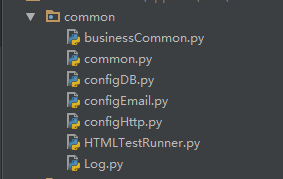
既然配置文件和讀取配置文件我們都已經完成了,也看到了common裏的內容,接下來就可以寫common裏的共通方法了,從哪個下手呢?今天,我們就來翻“Log.py”的牌吧,因為它是比較獨立的,我們單獨跟他打交道,也為了以後它能為我們服務打下良好基礎。
這裏呢,我想跟大家多說兩句,對於這個log文件呢,我給它單獨啟用了一個線程,這樣在整個運行過程中,我們在寫log的時候也會比較方便,看名字大家也知道了,這裏就是我們對輸出的日誌的所有操作了,主要是對輸出格式的規定,輸出等級的定義以及其他一些輸出的定義等等。總之,你想對log做的任何事情,都可以放到這裏來。我們來看下代碼,沒有比這個更直接有效的了。
import logging
from datetime import datetime
import threading首先,我們要像上面那樣,引入需要的模塊,才能進行接下來的操作。
class Log:
def __init__(self):
global logPath, resultPath, proDir
proDir = readConfig.proDir
resultPath = os.path.join(proDir, "result")
# create result file if it doesn‘t exist
if not os.path.exists(resultPath):
os.mkdir(resultPath)
# defined test result file name by localtime
logPath = os.path.join(resultPath, str(datetime.now().strftime("%Y%m%d%H%M%S")))
# create test result file if it doesn‘t exist
if not os.path.exists(logPath):
os.mkdir(logPath)
# defined logger
self.logger = logging.getLogger()
# defined log level
self.logger.setLevel(logging.INFO)
# defined handler
handler = logging.FileHandler(os.path.join(logPath, "output.log"))
# defined formatter
formatter = logging.Formatter(‘%(asctime)s - %(name)s - %(levelname)s - %(message)s‘)
# defined formatter
handler.setFormatter(formatter)
# add handler
self.logger.addHandler(handler),現在,我們創建了上面的Log類,在__init__初始化方法中,我們進行了log的相關初始化操作。具體的操作內容,註釋已經寫得很清楚了(英文有點兒差,大家看得懂就行,嘿嘿……),這樣,log的基本格式已經定義完成了,至於其他的方法,就靠大家自己發揮了,畢竟每個人的需求也不同,我們就只寫普遍的共用方法啦。接下來,就是把它放進一個線程內了,請看下面的代碼:
class MyLog:
log = None
mutex = threading.Lock()
def __init__(self):
pass
@staticmethod
def get_log():
if MyLog.log is None:
MyLog.mutex.acquire()
MyLog.log = Log()
MyLog.mutex.release()
return MyLog.log看起來是不是沒有想象中的那樣復雜啊,哈哈哈,就是這樣簡單,python比java簡單了許多,這也是我為什麽選擇它的原因,雖然小編我也是剛剛學習,還有很多不懂的地方。關於python中線程的學習,不懂的同學可以點擊這裏https://my.oschina.net/u/3041656/blog/794357,進行學習哦。希望大家跟我一同進步。好了,至此log的內容也結束了,是不是感覺自己棒棒噠~其實,無論什麽時候,都不要感到害怕,要相信“世上無難事只怕有心人”。
下面,我們繼續搭建,這次要做的,是configHttp.py的內容。沒錯,我們開始配置接口文件啦!(終於寫到接口了,是不是很開心啊~)
下面是接口文件中主要部分的內容,讓我們一起來看看吧。
import requests
import readConfig as readConfig
from common.Log import MyLog as Log
localReadConfig = readConfig.ReadConfig()
class ConfigHttp:
def __init__(self):
global host, port, timeout
host = localReadConfig.get_http("baseurl")
port = localReadConfig.get_http("port")
timeout = localReadConfig.get_http("timeout")
self.log = Log.get_log()
self.logger = self.log.get_logger()
self.headers = {}
self.params = {}
self.data = {}
self.url = None
self.files = {}
def set_url(self, url):
self.url = host + url
def set_headers(self, header):
self.headers = header
def set_params(self, param):
self.params = param
def set_data(self, data):
self.data = data
def set_files(self, file):
self.files = file
# defined http get method
def get(self):
try:
response = requests.get(self.url, params=self.params, headers=self.headers, timeout=float(timeout))
# response.raise_for_status()
return response
except TimeoutError:
self.logger.error("Time out!")
return None
# defined http post method
def post(self):
try:
response = requests.post(self.url, headers=self.headers, data=self.data, files=self.files, timeout=float(timeout))
# response.raise_for_status()
return response
except TimeoutError:
self.logger.error("Time out!")
return None這裏我們就挑重點來說吧。首先,可以看到,小編這次是用python自帶的requests來進行接口測試的,相信有心的朋友已經看出來了,python+requests這個模式是很好用的,它已經幫我們封裝好了測試接口的方法,用起來很方便。這裏呢,我就拿get和post兩個方法來說吧。(平時用的最多的就是這兩個方法了,其他方法,大家可以仿照著自行擴展)
- get方法
接口測試中見到最多的就是get方法和post方法,其中,get方法用於獲取接口的測試,說白了,就是說,使用get的接口,都不會對後臺數據進行更改,而且get方法在傳遞參數後,url的格式是這樣的:http://接口地址?key1=value1&key2=value2,是不是看起來很眼熟啊~(反正我看著它很眼熟~\(≧▽≦)/~啦啦啦),那我們要怎麽使用它呢,請繼續往下看。
對於requests提供的get方法,有幾個常用的參數:
url:顯而易見,就是接口的地址url啦
headers:定制請求頭(headers),例如:content-type = application/x-www-form-urlencoded
params:用於傳遞測試接口所要用的參數,這裏我們用python中的字典形式(key:value)進行參數的傳遞。
timeout:設置接口連接的最大時間(超過該時間會拋出超時錯誤)
現在,各個參數我們已經知道是什麽意思了,剩下的就是往裏面填值啦,是不是機械式的應用啊,哈哈,小編我就是這樣機械般的學習的啦~
舉個栗子:
url=‘http://api.shein.com/v2/member/logout’
header={‘content-type’: application/x-www-form-urlencoded}
param={‘user_id’: 123456,‘email’: [email protected]}
timeout=0.5
requests.get(url, headers=header, params=param, timeout=timeout)
- post方法
與get方法類似,只要設置好對應的參數,就可以了。下面就直接舉個栗子,直接上代碼吧:
url=‘http://api.shein.com/v2/member/login’
header={‘content-type’: application/x-www-form-urlencoded}
data={‘email’: 123456@163.com,‘password’: 123456}
timeout=0.5
requests.post(url, headers=header, data=data, timeout=timeout)
怎麽樣,是不是也很簡單啊。這裏我們需要說明一下,post方法中的參數,我們不在使用params進行傳遞,而是改用data進行傳遞了。哈哈哈,終於說完啦,下面我們來探(了)討(解)下接口的返回值。
依然只說常用的返回值的操作。
text:獲取接口返回值的文本格式
json():獲取接口返回值的json()格式
status_code:返回狀態碼(成功為:200)
headers:返回完整的請求頭信息(headers[‘name‘]:返回指定的headers內容)
encoding:返回字符編碼格式
url:返回接口的完整url地址
以上這些,就是常用的方法啦,大家可自行取之。
關於失敗請求拋出異常,我們可以使用“raise_for_status()”來完成,那麽,當我們的請求發生錯誤時,就會拋出異常。在這裏提醒下各位朋友,如果你的接口,在地址不正確的時候,會有相應的錯誤提示(有時也需要進行測試),這時,千萬不能使用這個方法來拋出錯誤,因為python自己在鏈接接口時就已經把錯誤拋出,那麽,後面你將無法測試期望的內容。而且程序會直接在這裏當掉,以錯誤來計。(別問我怎麽知道的,因為我就是測試的時候發現的)
好了。接口文件也講完了,是不是感覺離成功不遠了呢?嗯,如果各位已經看到了這裏,那麽恭喜大家,下面還有很長的路要走~哈哈哈,就是這麽任性。(畢竟小編我為了讓各位和我差不多的小白能夠更容易理解,也是使出了體內的洪荒之力啦)
慢慢地長嘆一口氣,繼續下面的內容。。。
快,我想學(看)習(看)common.py裏的內容。
import os
from xlrd import open_workbook
from xml.etree import ElementTree as ElementTree
from common.Log import MyLog as Log
localConfigHttp = configHttp.ConfigHttp()
log = Log.get_log()
logger = log.get_logger()
# 從excel文件中讀取測試用例
def get_xls(xls_name, sheet_name):
cls = []
# get xls file‘s path
xlsPath = os.path.join(proDir, "testFile", xls_name)
# open xls file
file = open_workbook(xlsPath)
# get sheet by name
sheet = file.sheet_by_name(sheet_name)
# get one sheet‘s rows
nrows = sheet.nrows
for i in range(nrows):
if sheet.row_values(i)[0] != u‘case_name‘:
cls.append(sheet.row_values(i))
return cls
# 從xml文件中讀取sql語句
database = {}
def set_xml():
if len(database) == 0:
sql_path = os.path.join(proDir, "testFile", "SQL.xml")
tree = ElementTree.parse(sql_path)
for db in tree.findall("database"):
db_name = db.get("name")
# print(db_name)
table = {}
for tb in db.getchildren():
table_name = tb.get("name")
# print(table_name)
sql = {}
for data in tb.getchildren():
sql_id = data.get("id")
# print(sql_id)
sql[sql_id] = data.text
table[table_name] = sql
database[db_name] = table
def get_xml_dict(database_name, table_name):
set_xml()
database_dict = database.get(database_name).get(table_name)
return database_dict
def get_sql(database_name, table_name, sql_id):
db = get_xml_dict(database_name, table_name)
sql = db.get(sql_id)
return sql上面就是我們common的兩大主要內容了,什麽?還不知道是什麽嗎?讓我告訴你吧。
- 我們利用xml.etree.Element來對xml文件進行操作,然後通過我們自定義的方法,根據傳遞不同的參數取得不(想)同(要)的值。
- 利用xlrd來操作excel文件,註意啦,我們是用excel文件來管理測試用例的。
聽起來會不會有點兒懵,小編剛學時也很懵,看文件就好理解了。
excel文件:

xml文件:
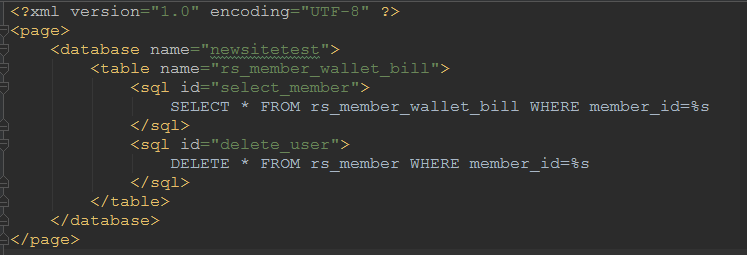
至於具體的方法,我就不再一點點講解了,總覺得大家都懂(小編剛學,望諒解),只是我個人需要詳細記錄,以後容易溫習。還有不會的小夥伴,可以參見這兩篇文章學習下:excel:https://my.oschina.net/u/3041656/blog/819892 xml:https://my.oschina.net/u/3041656/blog/819895
接下來,我們看看數據庫和發送郵件吧(也可根據需要,不寫該部分內容)
先看老朋友“數據庫”吧。
小編這次使用的是MySQL數據庫,所以我們就以它為例吧。
import pymysql
import readConfig as readConfig
from common.Log import MyLog as Log
localReadConfig = readConfig.ReadConfig()
class MyDB:
global host, username, password, port, database, config
host = localReadConfig.get_db("host")
username = localReadConfig.get_db("username")
password = localReadConfig.get_db("password")
port = localReadConfig.get_db("port")
database = localReadConfig.get_db("database")
config = {
‘host‘: str(host),
‘user‘: username,
‘passwd‘: password,
‘port‘: int(port),
‘db‘: database
}
def __init__(self):
self.log = Log.get_log()
self.logger = self.log.get_logger()
self.db = None
self.cursor = None
def connectDB(self):
try:
# connect to DB
self.db = pymysql.connect(**config)
# create cursor
self.cursor = self.db.cursor()
print("Connect DB successfully!")
except ConnectionError as ex:
self.logger.error(str(ex))
def executeSQL(self, sql, params):
self.connectDB()
# executing sql
self.cursor.execute(sql, params)
# executing by committing to DB
self.db.commit()
return self.cursor
def get_all(self, cursor):
value = cursor.fetchall()
return value
def get_one(self, cursor):
value = cursor.fetchone()
return value
def closeDB(self):
self.db.close()
print("Database closed!")這就是完整的數據庫的文件啦。因為小編的需求對數據庫的操作不是很復雜,所以這些已基本滿足要求啦。註意下啦,在此之前,請朋友們先把pymysql裝起來!pymysql裝起來!pymysql裝起來!(重要的事情說三遍),安裝的方法很簡單,由於小編是使用pip來管理python包安裝的,所以只要進入python安裝路徑下的pip文件夾下,執行以下命令即可:
pip install pymysql
哈哈哈,這樣我們就可以利用python鏈接數據庫啦~(鼓個掌,慶祝下)
小夥伴們發現沒,在整個文件中,我們並沒有出現具體的變量值哦,為什麽呢?沒錯,因為前面我們寫了config.ini文件,所有的數據庫配置信息都在這個文件內哦,是不是感覺很方便呢,以後就算變更數據庫了,也只要修改config.ini文件的內容就可以了,結合前面測試用例的管理(excel文件),sql語句的存放(xml文件),還有接下來我們要說的,businessCommon.py和存放具體case的文件夾,那麽我們就已經將數據和業務分開啦,哈哈哈,想想以後修改測試用例內容,sql語句神馬的工作,再也不用每個case都修改,只要改幾個固定的文件,是不是頓時開心了呢?(嗯,想笑就大聲的笑吧)
回歸上面的configDB.py文件,內容很簡單,相信大家都能看得懂,就是連接數據庫,執行sql,獲取結果,最後關閉數據庫,沒有什麽不一樣的地方。還有不明白的朋友可以查看這個鏈接進行學習:http://www.runoob.com/python/python-mysql.html
該談談郵件啦,你是不是也遇到過這樣的問題:每次測試完之後,都需要給開發一份測試報告。那麽,對於我這樣的懶人,是不願意老是找人家開發的,所以,我就想,每次測試完,我們可以讓程序自己給開發人員發一封email,告訴他們,測試已經結束了,並且把測試報告以附件的形式,通過email發送給開發者的郵箱,這樣豈不是爽哉!
所以,configEmail.py應運而生。當當當當……請看:
import os
import smtplib
from email.mime.multipart import MIMEMultipart
from email.mime.text import MIMEText
from datetime import datetime
import threading
import readConfig as readConfig
from common.Log import MyLog
import zipfile
import glob
localReadConfig = readConfig.ReadConfig()
class Email:
def __init__(self):
global host, user, password, port, sender, title, content
host = localReadConfig.get_email("mail_host")
user = localReadConfig.get_email("mail_user")
password = localReadConfig.get_email("mail_pass")
port = localReadConfig.get_email("mail_port")
sender = localReadConfig.get_email("sender")
title = localReadConfig.get_email("subject")
content = localReadConfig.get_email("content")
self.value = localReadConfig.get_email("receiver")
self.receiver = []
# get receiver list
for n in str(self.value).split("/"):
self.receiver.append(n)
# defined email subject
date = datetime.now().strftime("%Y-%m-%d %H:%M:%S")
self.subject = title + " " + date
self.log = MyLog.get_log()
self.logger = self.log.get_logger()
self.msg = MIMEMultipart(‘mixed‘)
def config_header(self):
self.msg[‘subject‘] = self.subject
self.msg[‘from‘] = sender
self.msg[‘to‘] = ";".join(self.receiver)
def config_content(self):
content_plain = MIMEText(content, ‘plain‘, ‘utf-8‘)
self.msg.attach(content_plain)
def config_file(self):
# if the file content is not null, then config the email file
if self.check_file():
reportpath = self.log.get_result_path()
zippath = os.path.join(readConfig.proDir, "result", "test.zip")
# zip file
files = glob.glob(reportpath + ‘\*‘)
f = zipfile.ZipFile(zippath, ‘w‘, zipfile.ZIP_DEFLATED)
for file in files:
f.write(file)
f.close()
reportfile = open(zippath, ‘rb‘).read()
filehtml = MIMEText(reportfile, ‘base64‘, ‘utf-8‘)
filehtml[‘Content-Type‘] = ‘application/octet-stream‘
filehtml[‘Content-Disposition‘] = ‘attachment; filename="test.zip"‘
self.msg.attach(filehtml)
def check_file(self):
reportpath = self.log.get_report_path()
if os.path.isfile(reportpath) and not os.stat(reportpath) == 0:
return True
else:
return False
def send_email(self):
self.config_header()
self.config_content()
self.config_file()
try:
smtp = smtplib.SMTP()
smtp.connect(host)
smtp.login(user, password)
smtp.sendmail(sender, self.receiver, self.msg.as_string())
smtp.quit()
self.logger.info("The test report has send to developer by email.")
except Exception as ex:
self.logger.error(str(ex))
class MyEmail:
email = None
mutex = threading.Lock()
def __init__(self):
pass
@staticmethod
def get_email():
if MyEmail.email is None:
MyEmail.mutex.acquire()
MyEmail.email = Email()
MyEmail.mutex.release()
return MyEmail.email
if __name__ == "__main__":
email = MyEmail.get_email()
這裏就是完整的文件內容了,不過可惜的是,小編我遇到一個問題,至今未解,在這裏提出,希望大神給出解決辦法!跪求啦!
問題:使用163免費郵箱服務器進行郵件的發送,但是,每次發送郵件,都會被163郵件服務器退信,拋出的錯誤碼是:554
官方說明如下:

但是,however,but……小編在整合email進本框架之前寫的發送email的小demo是可以正常發送郵件的。這個問題困擾著我,目前仍沒有解決,望大神賜教。
關於python對email的操作,上面代碼看不太明白的朋友,請移步這裏繼續學習:https://my.oschina.net/u/3041656/blog/819937
離成功不遠了,簡單說明下HTMLTestRunner.py文件,這個文件呢,也不是小編寫的,小編只是它的搬運工,哈哈哈,這個文件是從網上下載的,大神寫好的,用於生成html格式的測試報告,什麽?想知道生成測試報告的樣子?好,這就滿足好奇的你:
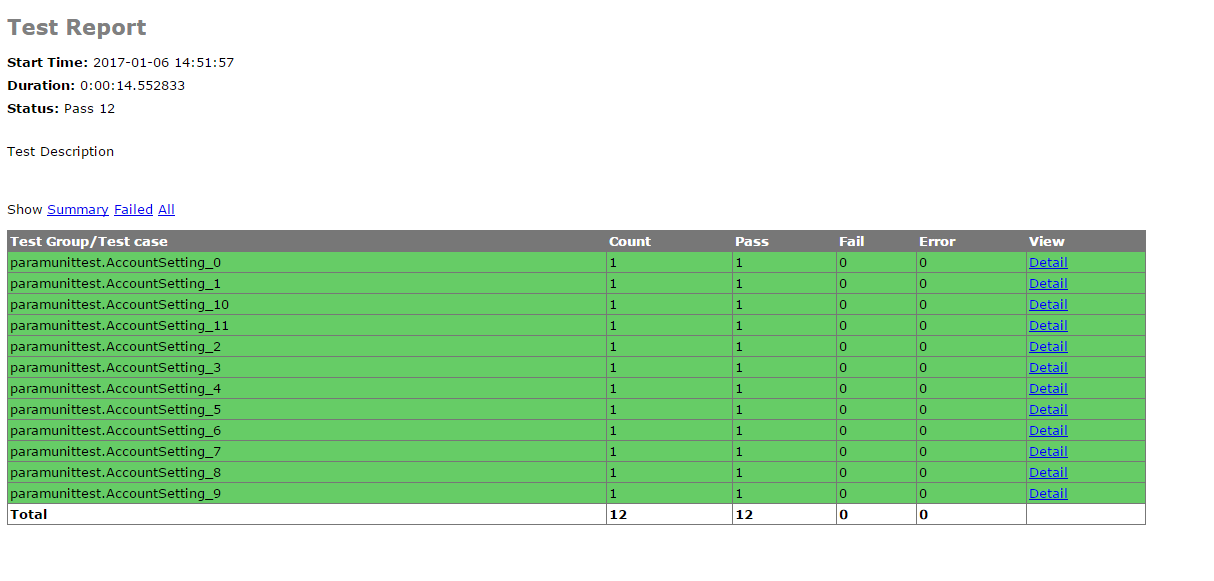
看上去不錯吧,嗯,聰明的你們,也可以自己去探索下這個文件,修改修改,變成你自己的style哦~
好了,重頭戲來了,就是我們的runAll.py啦。請看主角登場。
這是我們整個框架運行的入口,上面內容完成後,這是最後一步啦,寫完它,我們的框架就算是完成了。(鼓掌,撒花~)
import unittest
import HTMLTestRunner
def set_case_list(self):
fb = open(self.caseListFile)
for value in fb.readlines():
data = str(value)
if data != ‘‘ and not data.startswith("#"):
self.caseList.append(data.replace("\n", ""))
fb.close()
def set_case_suite(self):
self.set_case_list()
test_suite = unittest.TestSuite()
suite_model = []
for case in self.caseList:
case_file = os.path.join(readConfig.proDir, "testCase")
print(case_file)
case_name = case.split("/")[-1]
print(case_name+".py")
discover = unittest.defaultTestLoader.discover(case_file, pattern=case_name + ‘.py‘, top_level_dir=None)
suite_model.append(discover)
if len(suite_model) > 0:
for suite in suite_model:
for test_name in suite:
test_suite.addTest(test_name)
else:
return None
return test_suite
def run(self):
try:
suit = self.set_case_suite()
if suit is not None:
logger.info("********TEST START********")
fp = open(resultPath, ‘wb‘)
runner = HTMLTestRunner.HTMLTestRunner(stream=fp, title=‘Test Report‘, description=‘Test Description‘)
runner.run(suit)
else:
logger.info("Have no case to test.")
except Exception as ex:
logger.error(str(ex))
finally:
logger.info("*********TEST END*********")
# send test report by email
if int(on_off) == 0:
self.email.send_email()
elif int(on_off) == 1:
logger.info("Doesn‘t send report email to developer.")
else:
logger.info("Unknow state.")
上面我貼出了runAll裏面的主要部分,首先我們要從caselist.txt文件中讀取需要執行的case名稱,然後將他們添加到python自帶的unittest測試集中,最後執行run()函數,執行測試集。關於python的unittest,需要學的內容還是很多的,所以這裏小編就不細講了,朋友們可以移步這裏進行詳細的學習:https://docs.python.org/3/library/unittest.html 和 http://www.cnblogs.com/hero-blog/p/4128575.html 當然這裏只是小編給出的學習鏈接,大家可以自己Google一下,方法刷刷刷的就出來了。
終於呢,整個接口自動化框架已經講完了,大家是不是看明白了呢?什麽?之前的之前貼出的目錄結構中的文件還有沒說到的?嘿嘿,,,相信不用小編多說,大家也大概知道了,剩下文件夾的作用了。嗯~思索萬千,還是決定簡單談談吧。直接上圖,簡單明了:
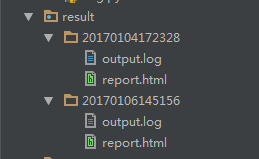
result文件夾會在首次執行case時生成,並且以後的測試結果都會被保存在該文件夾下,同時每次測試的文件夾都是用系統時間命名,裏面包含了兩個文件,log文件和測試報告。
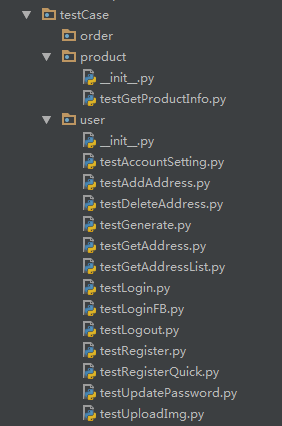
testCase文件夾下,存放我們寫的具體的測試case啦,上面這些就是小編寫的一些。註意嘍,所有的case名稱都要以test開頭來命名哦,這是因為,unittest在進行測試時會自動匹配testCase文件夾下面所有test開頭的.py文件
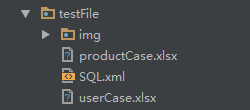
testFile文件夾下,放置我們測試時用來管理測試用例的excel文件和用於數據庫查詢的sql語句的xml文件哦。
最後就是caselist.txt文件了,就讓你們瞄一眼吧:
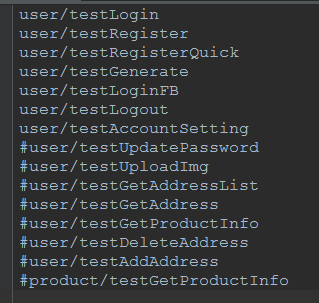
凡是沒有被註釋掉的,都是要被執行的case名稱啦。在這裏寫上你要執行的case名稱就可以啦。
呼~長舒一口氣,終於完成了整個過程,嗯,相信堅持看下來的你們一定會有所收獲的。在這裏,我要鄭重說一句:上文中提到的有關郵箱的問題,希望知道的大神賜教啊!!!
python+request+HTMLTestRunner+unittest接口自動化測試框架
